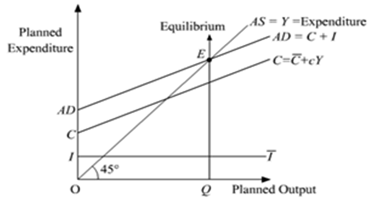Explain national income equilibrium through aggregate demand and aggregate supply. Use diagram. Also explain the changes that take place in an economy when the economy is not in equilibrium.
Equilibrium means the state of balance or state of no change. By equilibrium of national income we refer to that level of national income which remains unchanged at a particular level. In a simple economy, there are two elements of national income consumption and investment. An economy is said to be in equilibrium when aggregate expenditure equals aggregate income or aggregate money value of all goods and services.
There are two alternative approaches of national income determination and the first approach determines equilibrium level by the equality of aggregate demand and aggregate supply of output.
Under this approach, the equilibrium level of income is determined at the point where Aggregate Demand (AD) is equal to Aggregate Supply (AS).
In the diagram, consumption curve is depicted by C and the investment curve is depicted by the horizontal straight line parallel to the output/income axis. Summing-up the investment curve and consumption curve, we get the Aggregate Demand curve represented by AD = C + I. The Aggregate Supply curve is represented by the 45° line. Throughout this line, the planned expenditure is equal to the planned output. The point E is the equilibrium point, where the planned level of expenditure (AD) is equal to the planned level of output (AS). Accordingly, the equilibrium level of output (income) is OQ.
In case, if AD > AS, then it implies a situation, where the total demand for goods and services is more than the total supply of the goods and services. This implies a situation of excess demand. Due to the excess demand, the producers draw down their inventory and increase production. The increase in production requires hiring more factors of production, thereby increases employment level and income. Finally, the income will rise sufficiently to equate the AD with AS, thus the equilibrium is restored back.
On the other hand, In case, if AS > AD, then it implies a situation, where the total supply of goods and services is more than the total demand for the goods and services. This implies a situation of deficit demand. Due to the deficit demand, the producers experience piling-up of stock of unsold goods, i.e. inventory accumulation. This would force the producers to cut-back the production, thereby results in the reduced employment of factors of production. This leads to fall in the income and output. Finally, the income and output will fall sufficiently to equate the AD with AS, thus the equilibrium is restored back.
